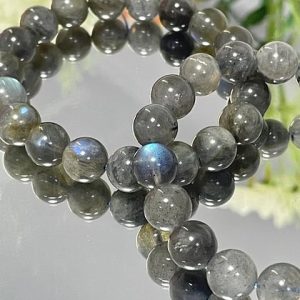Labradorite, a unique and captivating gemstone, has long fascinated collectors and gem enthusiasts. Its remarkable play of color and deep historical significance make it a gem worth exploring in detail.
Composition and Appearance
Chemical Structure
Labradorite is a member of the plagioclase feldspar family. This mineral group is characterized by its complex chemical formula: (Ca,Na)(Al,Si)_4O_8, where calcium and sodium exchange places within the crystal lattice. This interchangeability contributes to the stone's unique reflective properties.
Visual Characteristics
The most striking feature of Labradorite is its labradorescence, a term that describes the stone's remarkable ability to reflect light in a spectrum of colors. This phenomenon occurs due to the interference of light waves in the internal structures of the stone. Depending on the angle of light and observation, labradorite can display a range of colors, from deep blue and green to golden and even purple hues.
Geological Formation and Sources
Formation Process
Labradorite forms in igneous rocks, typically basalt, through a slow cooling process. This gradual cooling allows the formation of large, well-formed crystals. The unique conditions under which labradorite forms are what give rise to its distinct optical properties.
Primary Mining Locations
The most significant deposits of labradorite are found in Canada, particularly in the province of Newfoundland and Labrador, after which the stone is named. Other notable sources include Australia, Madagascar, Mexico, Russia, and the United States.

Historical and Cultural Significance
Mythological Roots
Inuit tribes believed that labradorite contained the Northern Lights trapped within its structure. According to legend, a warrior struck the stone with his spear, releasing the lights into the sky. This myth highlights the deep cultural and spiritual significance of labradorite to indigenous peoples.
Modern Uses
Today, labradorite is popular in jewelry and decorative objects. Its unique color play makes it a favorite among designers and collectors. Beyond aesthetics, it's also believed to have metaphysical properties, such as enhancing intuition and providing protection.
For more detailed information and to view a collection of Labradorite specimens, visit the provided link.